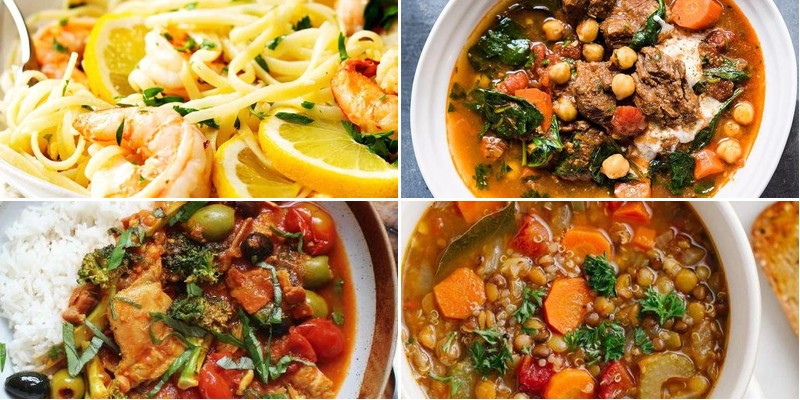Hey there, busy home cooks! Have you ever wished for delicious, healthy Mediterranean meals that practically cook themselves? Imagine coming home to the incredible aroma of garlic, herbs, and simmering vegetables—all ready to enjoy. Our collection of 30 crock pot recipes brings the vibrant flavors of the Mediterranean right to your kitchen, making wholesome dinners effortless and absolutely irresistible. Get ready to be inspired!
Mediterranean Chicken Stew with Olives
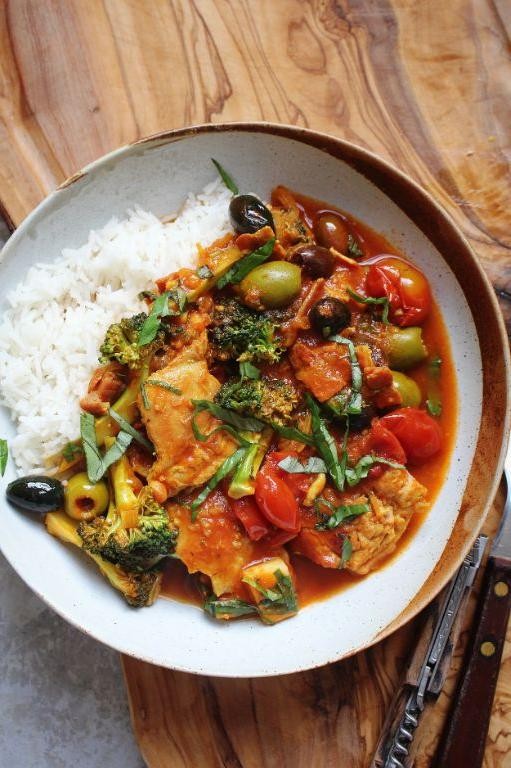
Lately, I’ve found myself craving something warm and deeply comforting, a dish that simmers slowly and fills the kitchen with the scent of herbs and briny olives. This Mediterranean chicken stew came together on one of those quiet afternoons when time felt expansive, and each step felt like a small, mindful ritual. It’s the kind of meal that asks for little but gives so much in return.
Ingredients
- 2 tablespoons extra virgin olive oil—my go-to for its fruity depth
- 1.5 pounds boneless, skinless chicken thighs, patted dry for better browning
- 1 large yellow onion, diced into ½-inch pieces
- 3 cloves garlic, minced—I love using fresh for that sharp, aromatic kick
- 1 teaspoon dried oregano, rubbed between my palms to wake up the oils
- ½ teaspoon smoked paprika, for a subtle warmth
- 1 (14.5-ounce) can diced tomatoes, with their juices
- 1 cup chicken broth, low-sodium so I can control the seasoning
- ½ cup pitted Kalamata olives, roughly chopped—their saltiness balances the stew perfectly
- 2 tablespoons fresh lemon juice, squeezed right before adding to keep it bright
- ¼ cup chopped fresh parsley, stirred in at the end for a pop of color and freshness
Instructions
- Heat 2 tablespoons of extra virgin olive oil in a large Dutch oven over medium-high heat until it shimmers, about 2 minutes.
- Pat 1.5 pounds of boneless, skinless chicken thighs dry with paper towels, then season both sides evenly with 1 teaspoon of kosher salt and ½ teaspoon of black pepper.
- Place the chicken thighs in the hot oil and sear until golden brown, 5–6 minutes per side, working in batches if needed to avoid crowding the pan.
- Transfer the seared chicken to a clean plate, leaving the rendered fat and oil in the pot.
- Add 1 large diced yellow onion to the pot and cook, stirring occasionally, until softened and translucent, about 5 minutes.
- Stir in 3 minced garlic cloves and cook until fragrant, 30–45 seconds, being careful not to let it burn.
- Sprinkle in 1 teaspoon of dried oregano and ½ teaspoon of smoked paprika, stirring constantly to toast the spices for 30 seconds.
- Pour in 1 can of diced tomatoes with their juices and 1 cup of low-sodium chicken broth, scraping the bottom of the pot to lift any browned bits.
- Return the seared chicken thighs and any accumulated juices to the pot, nestling them into the liquid.
- Bring the stew to a gentle boil, then reduce the heat to low, cover, and simmer for 25 minutes to allow the flavors to meld.
- Uncover the pot and stir in ½ cup of roughly chopped pitted Kalamata olives and 2 tablespoons of fresh lemon juice.
- Continue simmering uncovered for 10 minutes, until the chicken is tender and the sauce has thickened slightly.
- Remove the pot from the heat and stir in ¼ cup of chopped fresh parsley just before serving.
Unfolding with each spoonful, the stew yields tender chicken that falls apart effortlessly, while the briny olives and bright lemon weave through the rich, tomato-infused broth. I love ladling it over a mound of creamy polenta or scooping it up with crusty bread to catch every last drop. It’s a humble, soul-soothing bowl that feels like a quiet celebration of simple, honest ingredients.
Slow-Cooked Greek Lemon Chicken
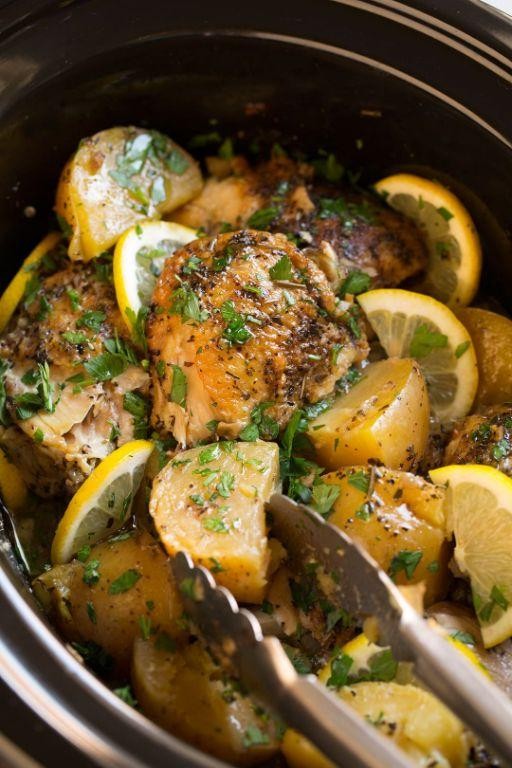
There’s something quietly magical about how chicken transforms when given time and lemon’s bright kiss, filling the kitchen with a scent that feels like a gentle embrace on any ordinary evening. This slow-cooked version, inspired by Greek taverna memories, turns simple ingredients into something deeply comforting and effortlessly elegant.
Ingredients
– 3 lbs bone-in, skin-on chicken thighs (the bones keep everything moist)
– 1/4 cup extra virgin olive oil, my go-to for its fruity depth
– 1/3 cup fresh lemon juice, squeezed from about 2 large lemons I roll firmly first
– 4 cloves garlic, minced (I love the pungent aroma as it hits the cutting board)
– 1 tsp dried oregano, rubbed between my palms to wake up its oils
– 1/2 tsp salt, fine sea salt for even distribution
– 1/4 tsp black pepper, freshly ground for that subtle heat
– 1 cup chicken broth, low-sodium so I control the seasoning
– 1 lb baby potatoes, halved if larger than a walnut
Instructions
1. Pat the chicken thighs completely dry with paper towels to ensure crisp skin.
2. Whisk together olive oil, lemon juice, minced garlic, oregano, salt, and pepper in a small bowl.
3. Arrange chicken thighs skin-side up in a single layer in a 6-quart slow cooker.
4. Pour the lemon-herb mixture evenly over the chicken, making sure each piece is coated.
5. Scatter baby potatoes around the chicken in the slow cooker.
6. Pour chicken broth gently around the edges to avoid washing off the marinade.
7. Cover and cook on Low for 6 hours until chicken reaches 165°F internally and potatoes are fork-tender.
8. Carefully transfer chicken and potatoes to a serving platter using tongs and a slotted spoon.
9. Skim excess fat from the cooking liquid in the slow cooker with a spoon.
10. Serve the chicken and potatoes drizzled with the remaining cooking liquid.
The chicken falls apart with just a gentle nudge of your fork, its tender meat infused with lemon’s bright acidity that cuts through the rich olive oil. I love serving it over orzo that soaks up every drop of the garlicky broth, or with a simple arugula salad for contrasting freshness.
Crock Pot Moroccan Vegetable Tagine
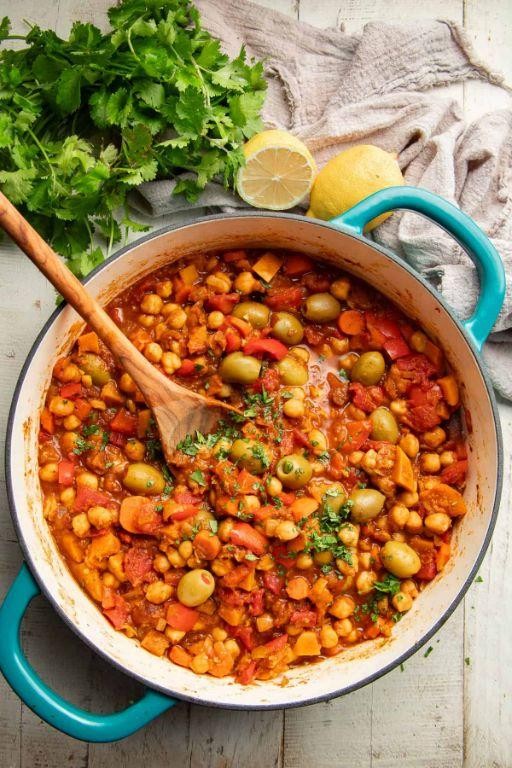
Beneath the gentle hum of the crock pot, there’s a quiet magic that unfolds, transforming humble vegetables into something deeply comforting and fragrant, a slow dance of spices and steam that feels like a warm embrace on a crisp autumn afternoon.
Ingredients
– 1 large yellow onion, thinly sliced—I find the sweetness really blooms when cooked low and slow
– 3 cloves garlic, minced (fresh is always my preference for that bright, pungent kick)
– 1 tablespoon extra virgin olive oil, my go-to for its fruity notes
– 1 teaspoon ground cumin, toasty and earthy
– 1 teaspoon smoked paprika, for a subtle smoky depth
– 1/2 teaspoon ground cinnamon, just a whisper to warm the soul
– 1/4 teaspoon cayenne pepper, for a gentle heat that lingers
– 1 (14.5-ounce) can diced tomatoes, with their juices—they create the most lovely, saucy base
– 1 cup vegetable broth, low-sodium so you can control the salt
– 1 medium sweet potato, peeled and cut into 1-inch chunks—they hold their shape beautifully
– 2 medium carrots, sliced into 1/2-inch rounds, for a touch of natural sweetness
– 1 (15-ounce) can chickpeas, rinsed and drained; I love how they soak up all the flavors
– 1/2 cup dried apricots, chopped—they plump up and add a lovely chewy texture
– 1/2 teaspoon fine sea salt, to layer the seasoning evenly
– 1/4 cup fresh cilantro, chopped, for a bright finish right at the end
Instructions
1. Heat 1 tablespoon extra virgin olive oil in a skillet over medium heat until it shimmers, about 1 minute.
2. Add 1 large yellow onion, thinly sliced, and cook, stirring occasionally, until softened and lightly golden, about 5–7 minutes.
3. Stir in 3 cloves garlic, minced, and cook for 1 minute until fragrant—be careful not to burn it, as it can turn bitter.
4. Transfer the onion and garlic mixture to the crock pot insert.
5. Sprinkle 1 teaspoon ground cumin, 1 teaspoon smoked paprika, 1/2 teaspoon ground cinnamon, and 1/4 teaspoon cayenne pepper directly over the onions and garlic to toast the spices lightly in the residual heat.
6. Pour in 1 (14.5-ounce) can diced tomatoes with their juices and 1 cup vegetable broth, stirring to combine everything evenly.
7. Add 1 medium sweet potato, peeled and cut into 1-inch chunks, 2 medium carrots, sliced into 1/2-inch rounds, 1 (15-ounce) can chickpeas, rinsed and drained, and 1/2 cup dried apricots, chopped, layering them gently into the liquid.
8. Stir in 1/2 teaspoon fine sea salt until well distributed.
9. Cover the crock pot and cook on Low heat for 6 hours, until the sweet potatoes and carrots are tender when pierced with a fork—this slow simmer melds the flavors beautifully.
10. Tip: For a thicker sauce, remove the lid during the last 30 minutes of cooking to allow some liquid to evaporate.
11. Stir in 1/4 cup fresh cilantro, chopped, just before serving to keep its vibrant color and fresh flavor intact. Ultimately, the tender sweet potatoes and carrots melt into the spiced broth, while the chickpeas and apricots offer little bursts of texture, creating a dish that’s both hearty and subtly sweet. I love serving it over fluffy couscous or with warm, crusty bread to soak up every last bit of the fragrant sauce.
Herb-Infused Beef and Chickpea Ragout
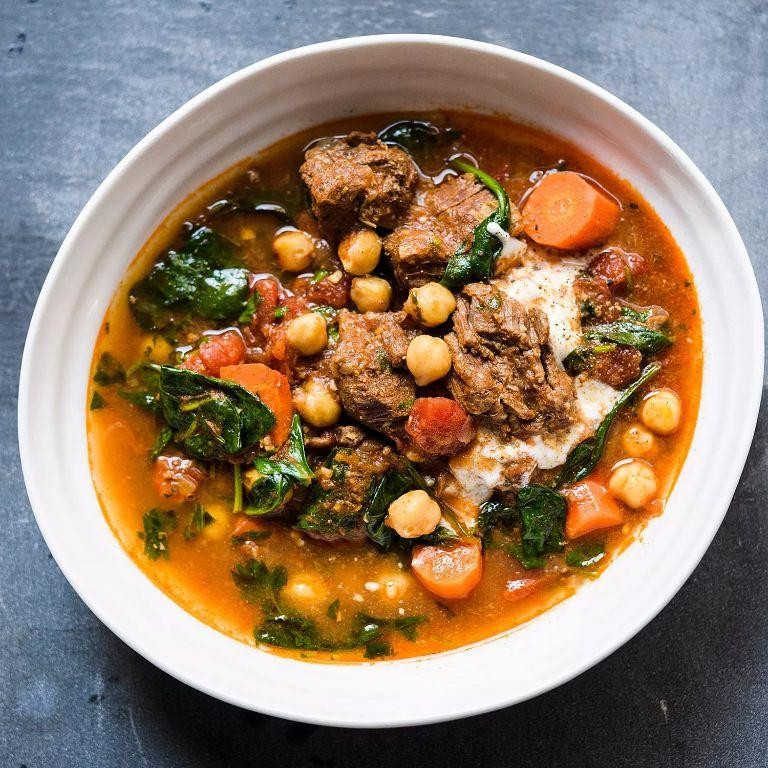
Sometimes, on these quiet autumn evenings, I find myself drawn to the kitchen, where the slow simmer of a ragout fills the house with a warmth that feels like a gentle embrace. There’s something deeply comforting about letting beef and chickpeas mingle with herbs over low heat, each ingredient softening and blending until the entire pot becomes a rich, cohesive whole. It’s a dish that asks for patience but rewards it generously, filling not just the stomach but the soul with its humble, hearty presence.
Ingredients
– 1.5 lbs beef chuck, cut into 1-inch cubes (I like to trim excess fat for a cleaner finish)
– 2 tbsp extra virgin olive oil (my go-to for its fruity depth)
– 1 large yellow onion, finely chopped (sweet varieties work best here)
– 3 cloves garlic, minced (freshly crushed releases more aroma)
– 1 cup dry red wine (a bold Cabernet adds nice body)
– 4 cups beef broth, low-sodium (homemade stock elevates it, but store-bought works)
– 1 (15 oz) can chickpeas, rinsed and drained (I give them a quick pat dry to avoid sogginess)
– 2 tbsp tomato paste (double-concentrated for richer flavor)
– 1 tsp dried thyme (crushing it between my fingers wakes up the oils)
– 1 bay leaf (remove it before serving—it’s subtle but essential)
– Salt and black pepper (I start light and adjust at the end)
Instructions
1. Pat the beef cubes dry with paper towels to ensure a crisp sear.
2. Heat olive oil in a large Dutch oven over medium-high heat until it shimmers, about 2 minutes.
3. Sear beef in a single layer, turning to brown all sides, for 6–8 minutes total; work in batches to avoid steaming.
4. Transfer beef to a plate, leaving drippings in the pot.
5. Add onion and cook, stirring occasionally, until translucent and lightly golden, about 5 minutes.
6. Stir in garlic and cook for 1 minute until fragrant but not browned.
7. Pour in red wine, scraping the bottom to lift any browned bits—this deglazing step builds deep flavor.
8. Simmer wine until reduced by half, about 3–4 minutes.
9. Mix in tomato paste and cook for 1 minute to caramelize slightly.
10. Return beef to the pot, along with any accumulated juices.
11. Add beef broth, thyme, bay leaf, 1 tsp salt, and ½ tsp black pepper.
12. Bring to a boil, then reduce heat to low, cover, and simmer for 1 hour and 30 minutes until beef is fork-tender.
13. Stir in chickpeas and simmer uncovered for 15 minutes to warm through and thicken the sauce.
14. Discard the bay leaf and season with additional salt and pepper if needed.
Draped over creamy polenta or crusty bread, this ragout feels like a quiet celebration—tender beef shreds easily, while chickpeas add a subtle nuttiness that balances the herb-infused broth. Leftovers taste even deeper the next day, as if the flavors have settled into a cozy, whispered story.
Slow Cooker Ratatouille with Fresh Herbs
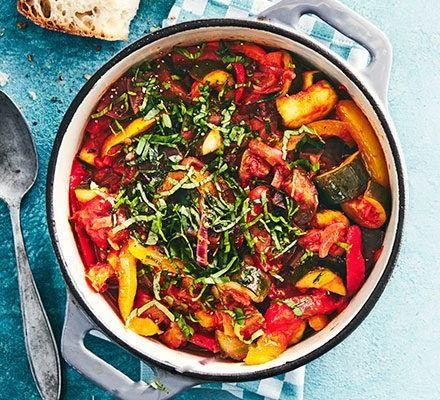
There’s something quietly magical about watching vegetables transform in the slow cooker, their colors deepening and flavors mingling over hours. This ratatouille feels like a gentle embrace on busy days, filling the kitchen with the earthy scent of herbs and simmering tomatoes. I love how it requires little more than chopping and patience, rewarding both with layers of comforting flavor.
Ingredients
– 2 medium eggplants, cut into 1-inch cubes (I always salt them first to draw out bitterness)
– 3 medium zucchini, sliced into ½-inch rounds (the smaller ones tend to be sweeter)
– 1 large yellow onion, thinly sliced (I prefer the milder sweetness of yellow over white)
– 2 red bell peppers, cut into 1-inch strips (their vibrant color holds up beautifully)
– 4 cloves garlic, minced (freshly minced makes all the difference)
– 1 (28-ounce) can crushed tomatoes (San Marzano are my favorite for their balanced acidity)
– ¼ cup extra virgin olive oil (my go-to for its fruity notes)
– 2 tablespoons fresh thyme leaves (gently stripped from the stems)
– 1 tablespoon fresh rosemary, finely chopped (it releases more fragrance when chopped fresh)
– 1 teaspoon fine sea salt (I find it distributes more evenly than kosher salt here)
– ½ teaspoon freshly ground black pepper (freshly ground has so much more aroma)
Instructions
1. Place eggplant cubes in a colander, sprinkle with 1 teaspoon salt, and let sit for 30 minutes to draw out excess moisture and bitterness.
2. Rinse the eggplant thoroughly under cold water and pat completely dry with paper towels.
3. Combine all vegetables, garlic, crushed tomatoes, olive oil, thyme, rosemary, salt, and pepper in a 6-quart slow cooker.
4. Stir gently until all ingredients are evenly coated with the tomato-olive oil mixture.
5. Cover and cook on LOW for 6 hours until vegetables are tender but still hold their shape.
6. Remove the lid during the last 30 minutes of cooking to allow excess liquid to evaporate and flavors to concentrate.
7. Taste and adjust seasoning with additional salt if needed, stirring gently to incorporate.
When the ratatouille finishes, the vegetables will be meltingly tender yet distinct, each bite carrying the bright acidity of tomatoes and earthy depth of herbs. I love serving it over creamy polenta or with crusty bread to soak up the rich juices, sometimes topping it with a drizzle of olive oil and fresh basil for contrast.
Lamb and Spinach Stew with Tomatoes
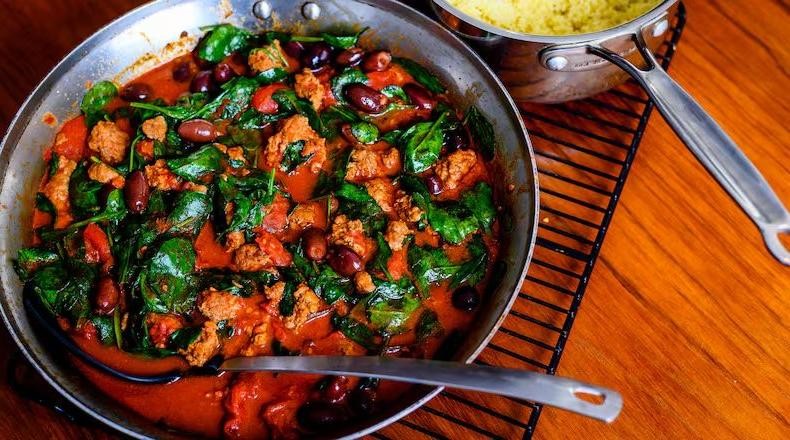
Mellow evenings call for dishes that simmer slowly, filling the kitchen with comforting aromas that linger like old memories. This lamb and spinach stew with tomatoes is one of those soul-warming creations that feels like a gentle embrace after a long day. There’s something deeply satisfying about watching the ingredients meld together, transforming into something greater than their parts.
Ingredients
– 2 lbs lamb shoulder, cut into 1-inch cubes (I find the shoulder has the perfect balance of flavor and tenderness)
– 1 large yellow onion, diced (the sweetness really develops during the slow cook)
– 4 cloves garlic, minced (freshly minced makes all the difference)
– 2 tbsp extra virgin olive oil (my go-to for its fruity notes)
– 1 (28 oz) can crushed tomatoes (I prefer San Marzano for their bright acidity)
– 4 cups fresh spinach (packed tightly – it wilts down significantly)
– 1 cup chicken broth (homemade if you have it, but store-bought works fine)
– 1 tsp dried oregano (rubbed between your palms to release the oils)
– 1/2 tsp red pepper flakes (adjust to your comfort level)
– Salt and black pepper (I’m generous with both)
Instructions
1. Pat the lamb cubes completely dry with paper towels – this ensures a proper sear rather than steaming.
2. Heat the olive oil in a large Dutch oven over medium-high heat until it shimmers, about 2 minutes.
3. Season the lamb generously with salt and pepper on all sides.
4. Working in batches to avoid crowding, sear the lamb cubes until deeply browned on all sides, about 3-4 minutes per side.
5. Transfer the seared lamb to a plate, leaving the rendered fat in the pot.
6. Reduce heat to medium and add the diced onion, cooking until translucent and slightly golden, about 6-8 minutes.
7. Add the minced garlic and cook for exactly 1 minute until fragrant but not browned.
8. Return the lamb and any accumulated juices to the pot.
9. Pour in the crushed tomatoes and chicken broth, scraping the bottom to release any browned bits.
10. Stir in the dried oregano and red pepper flakes until well combined.
11. Bring the stew to a gentle boil, then immediately reduce to the lowest simmer possible.
12. Cover and cook for 1 hour and 45 minutes, stirring occasionally to prevent sticking.
13. Uncover and continue simmering for another 15 minutes to slightly thicken the sauce.
14. Stir in the fresh spinach by handfuls, waiting for each addition to wilt before adding more.
15. Cook for exactly 2 more minutes until the spinach is fully incorporated but still vibrant green.
Zestful and deeply comforting, this stew achieves that perfect balance where the lamb becomes fork-tender while the spinach maintains its structural integrity. The tomatoes create a rich, slightly acidic base that cuts through the lamb’s richness beautifully. I love serving it over creamy polenta or with crusty bread to soak up every last bit of the fragrant sauce.
Garlic and Lemon Seafood Medley
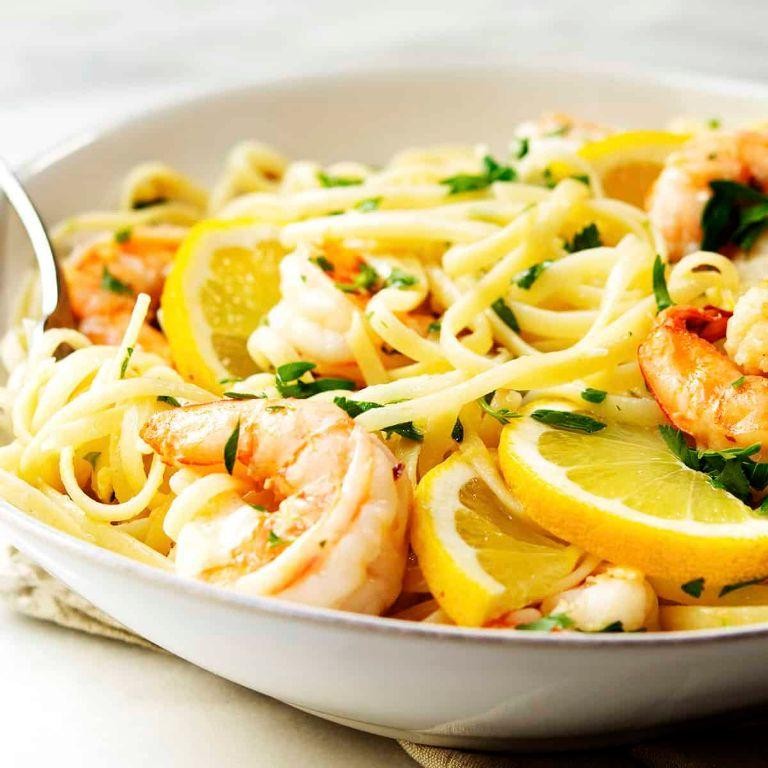
Sometimes, the simplest meals become the most memorable, like this garlic and lemon seafood medley I first made on a quiet evening when the ocean air drifted through my kitchen window, reminding me how elemental flavors can feel like coming home.
Ingredients
– 1 lb mixed seafood (shrimp, scallops, squid), thawed if frozen—I find the variety adds such lovely texture
– 4 cloves garlic, minced—freshly minced releases the most aromatic oils
– 2 tbsp extra virgin olive oil, my go-to for its fruity notes
– 1 lemon, juiced and zested—I always zest first to capture the bright oils
– 1/4 cup dry white wine, a crisp Sauvignon Blanc works beautifully here
– 2 tbsp unsalted butter, chilled for quick emulsifying
– 1/4 tsp red pepper flakes, for just a whisper of heat
– 1/4 cup chopped fresh parsley, stirred in at the end for freshness
Instructions
1. Pat the mixed seafood completely dry with paper towels to ensure a golden sear instead of steaming.
2. Heat the olive oil in a large skillet over medium-high heat until it shimmers, about 2 minutes.
3. Add the minced garlic and red pepper flakes, sautéing for 30 seconds until fragrant but not browned.
4. Arrange the seafood in a single layer in the skillet, searing for 2 minutes per side until the shrimp turn pink and scallops develop a golden crust.
5. Pour in the white wine and lemon juice, scraping up any browned bits from the pan bottom to build flavor.
6. Simmer the mixture for 3 minutes until the wine reduces by half and the seafood is cooked through.
7. Remove the skillet from heat and swirl in the cold butter until the sauce emulsifies and thickens slightly.
8. Stir in the lemon zest and chopped parsley just before serving to preserve their vibrant qualities. Creamy butter melds with the briny seafood and sharp lemon, creating a sauce that begs to be sopped up with crusty bread or spooned over angel hair pasta for a comforting, elegant meal.
Savory Feta and Spinach Frittata
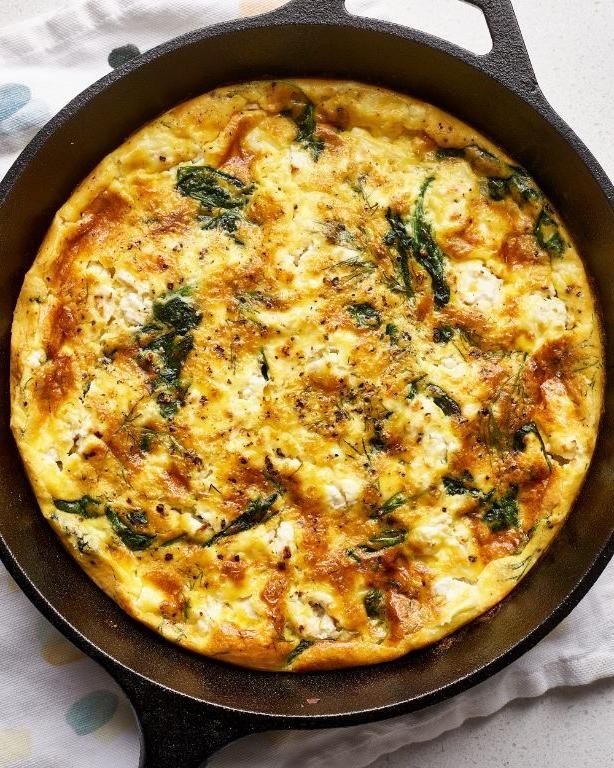
Years have a way of folding into one another, but some mornings still call for the same comforting ritual—the gentle sizzle of onions in the pan, the quiet whisking of eggs, a moment of peace before the day begins. Today feels like one of those mornings, where a simple frittata feels less like a meal and more like a quiet anchor. It’s a dish that holds space for reflection, just as much as it holds flavor.
Ingredients
– 8 large eggs (I prefer room temperature eggs here—they blend more smoothly and cook evenly)
– 1 cup fresh spinach, roughly chopped (I love how it wilts into soft green ribbons)
– 1/2 cup crumbled feta cheese (the salty tang is what makes this dish sing)
– 1/4 cup whole milk (a splash for creaminess, never skim)
– 1 small yellow onion, finely diced (it sweetens as it cooks, mellowing everything out)
– 2 tablespoons extra virgin olive oil (my go-to for its fruity notes)
– 1/2 teaspoon kosher salt (it dissolves better than table salt)
– 1/4 teaspoon black pepper, freshly ground
Instructions
1. Preheat your oven to 375°F to ensure it’s ready when the frittata goes in—this avoids a temperature drop.
2. Heat 2 tablespoons of extra virgin olive oil in a 10-inch oven-safe skillet over medium heat for 1 minute, until it shimmers lightly.
3. Add 1 small yellow onion, finely diced, and cook for 4–5 minutes, stirring occasionally, until the onion turns translucent and edges begin to golden.
4. Stir in 1 cup of fresh spinach, roughly chopped, and cook for 1–2 minutes, just until it wilts into soft, dark green folds.
5. In a medium bowl, whisk 8 large eggs with 1/4 cup whole milk until fully combined and slightly frothy—this incorporates air for a fluffier texture.
6. Mix in 1/2 teaspoon kosher salt and 1/4 teaspoon black pepper, freshly ground, distributing the seasonings evenly.
7. Pour the egg mixture over the spinach and onions in the skillet, tilting the pan to spread it uniformly.
8. Sprinkle 1/2 cup crumbled feta cheese evenly over the top, letting it settle into the eggs.
9. Cook on the stovetop for 3–4 minutes without stirring, until the edges set and pull slightly away from the pan.
10. Transfer the skillet to the preheated oven and bake for 12–15 minutes, until the center is fully set and no liquid egg remains when tested with a knife.
11. Remove the skillet from the oven using oven mitts—the handle will be hot—and let it rest for 2 minutes to firm up.
12. Slide a spatula around the edges and gently lift the frittata onto a cutting board.
This frittata emerges tender and golden, with pockets of salty feta melting into the creamy eggs. The spinach adds a subtle earthiness, while the onions lend a sweet backbone. Try serving it warm with a drizzle of olive oil or alongside toasted sourdough for a rustic breakfast that feels both nourishing and deeply comforting.
Tuscan White Bean and Kale Soup
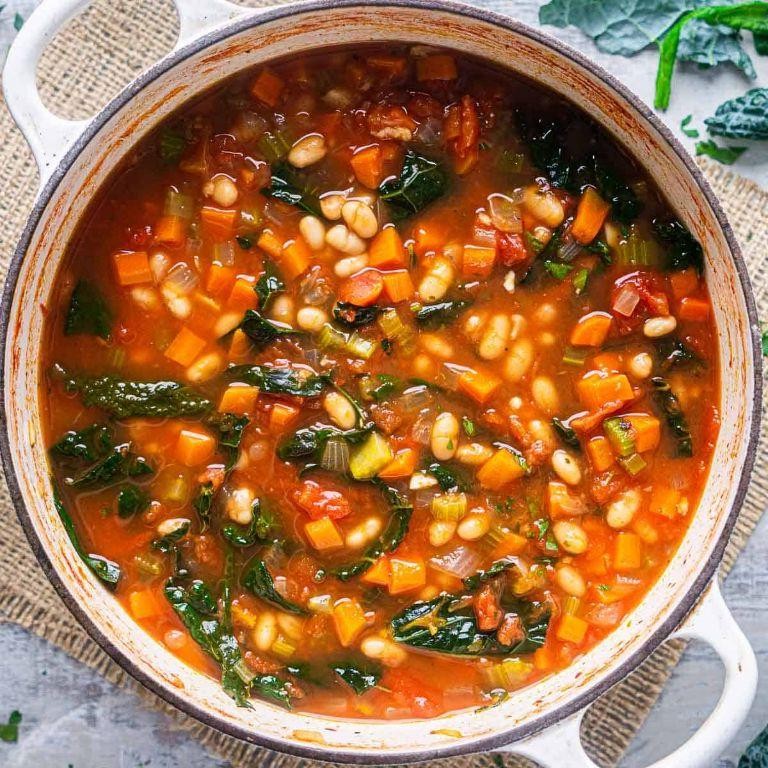
Evenings like this, when the air carries the first crisp whispers of autumn, my thoughts drift to the gentle comforts of a simmering pot on the stove, to the quiet alchemy of simple ingredients transforming into something deeply nourishing for the soul.
Ingredients
– 2 tablespoons extra virgin olive oil, my go-to for its fruity depth that forms the very soul of the soup
– 1 medium yellow onion, diced small—I find this size helps it melt into the broth more gracefully
– 2 large carrots, peeled and chopped into hearty half-moons for a bit of rustic texture
– 3 cloves garlic, minced finely to release all its fragrant potential
– 6 cups vegetable broth, using a good quality one makes all the difference in the world
– 2 (15-ounce) cans cannellini beans, rinsed well—I always give them a good shake in a colander to remove that starchy can liquid
– 1 large bunch of kale, stems removed and leaves torn into bite-sized pieces; I love the cavolo nero variety for its dark, crinkled leaves
– 1 teaspoon dried thyme, rubbed between my fingers first to wake up its earthy aroma
– 1/2 teaspoon red pepper flakes, just enough to provide a gentle warmth in the background
Instructions
1. Pour 2 tablespoons of extra virgin olive oil into a large Dutch oven or heavy-bottomed pot and place it over medium heat for 2 minutes until the oil shimmers.
2. Add the diced onion and chopped carrots to the pot, stirring occasionally with a wooden spoon for 8-10 minutes until the onion turns translucent and the carrots begin to soften at the edges.
3. Stir in the minced garlic and cook for exactly 1 minute until fragrant, being careful not to let it brown which would make it bitter.
4. Pour in 6 cups of vegetable broth, using a spatula to scrape up any browned bits from the bottom of the pot—those little caramelized pieces hold so much flavor.
5. Add the rinsed cannellini beans, dried thyme, and red pepper flakes to the broth.
6. Bring the soup to a lively boil over high heat, then immediately reduce the heat to low and cover the pot with a lid.
7. Simmer the soup gently for 15 minutes to allow the flavors to meld together beautifully.
8. Stir in the torn kale leaves and continue simmering uncovered for another 8-10 minutes until the kale has wilted and turned a vibrant dark green. Patience here yields perfectly tender kale that still has some structure.
9. Ladle the hot soup into deep bowls. Perhaps with a thick slice of crusty bread for dipping, this soup becomes a complete, comforting meal where the creamy beans and sturdy kale create a wonderful textural dance in every spoonful.
Mediterranean Stuffed Bell Peppers
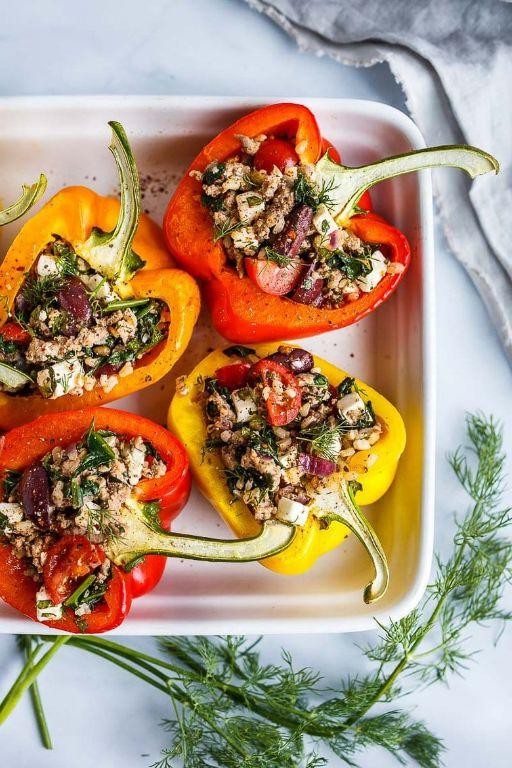
Often, when the evening light turns golden and the kitchen grows quiet, I find myself reaching for these humble vessels—their curved walls waiting to be filled with warmth and memory. There’s something deeply comforting about preparing Mediterranean stuffed bell peppers, a ritual that slows time and fills the air with the scent of earth and spice.
Ingredients
- 4 large bell peppers, any color—I love the sunset gradient of red, orange, and yellow
- 1 cup uncooked long-grain white rice, rinsed until the water runs clear to avoid gumminess
- 1 lb lean ground beef, 90/10 for just enough richness without excess grease
- 1 medium yellow onion, finely diced—the sharp bite mellows beautifully as it cooks
- 2 cloves garlic, minced (I always add an extra one, pressed fresh for maximum aroma)
- 1 (14.5 oz) can diced tomatoes, undrained—their juices keep everything moist
- 1 tsp dried oregano, rubbed between my palms to wake up the oils
- 1/2 tsp ground cumin, toasty and warm
- 2 tbsp extra virgin olive oil, my go-to for its fruity finish
- 1 cup shredded mozzarella cheese, for that gentle stretch
- 1/2 cup crumbled feta cheese, because its salty tang is non-negotiable here
- 1/4 cup chopped fresh parsley, stirred in at the end for a burst of green
- Salt and black pepper, measured with a generous hand
Instructions
- Preheat your oven to 375°F—this moderate heat cooks the peppers evenly without scorching.
- Slice the tops off the bell peppers and remove the seeds and membranes, saving the tops if you’d like to use them as little lids later.
- Bring 2 cups of water to a boil in a medium saucepan, then stir in the rinsed rice and 1/2 tsp salt.
- Reduce the heat to low, cover the pan, and simmer the rice for 18 minutes until tender and all water is absorbed.
- Heat the olive oil in a large skillet over medium heat until it shimmers.
- Add the diced onion and cook for 5–7 minutes, stirring occasionally, until translucent and fragrant.
- Stir in the minced garlic and cook for 1 minute more, just until golden—be careful not to burn it.
- Add the ground beef to the skillet, breaking it up with a wooden spoon, and cook for 8–10 minutes until no pink remains.
- Drain any excess fat from the skillet, then stir in the diced tomatoes with their juices, oregano, cumin, 1 tsp salt, and 1/2 tsp black pepper.
- Simmer the mixture for 5 minutes, allowing the flavors to meld and the liquid to reduce slightly.
- Remove the skillet from heat and fold in the cooked rice, parsley, and crumbled feta until well combined.
- Stuff the bell peppers generously with the filling, pressing down lightly to pack it in.
- Arrange the peppers upright in a baking dish just large enough to hold them snugly.
- Sprinkle the shredded mozzarella evenly over the tops of the stuffed peppers.
- Cover the dish tightly with foil and bake for 30 minutes.
- Remove the foil and bake for another 15–20 minutes, until the cheese is bubbly and lightly browned and the peppers are tender when pierced with a fork.
- Let the peppers rest for 5 minutes before serving—this allows the filling to set and makes them easier to handle.
Now, the peppers emerge tender yet firm, their sweetness deepened by the oven’s heat, while the filling stays moist and richly spiced. Nothing compares to that first bite—the creamy feta melting into the herbed rice, the savory beef, and the yielding pepper wall. Nestle them beside a simple green salad, or for a cozy twist, spoon any extra filling over toasted crusty bread to savor every last bit.
Eggplant Parmesan in a Crock Pot
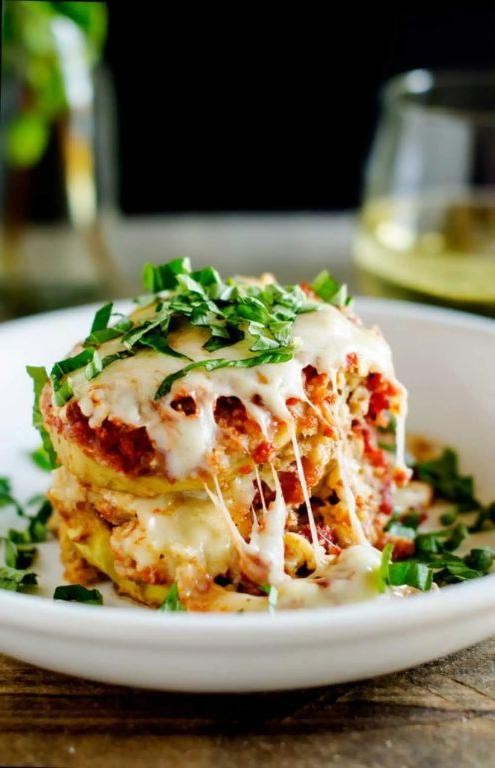
Venturing into the kitchen this evening felt like returning to an old friend, the slow, steady rhythm of the crock pot promising comfort without the usual rush. There’s something deeply soothing about layering flavors over hours, letting the humble eggplant transform into something rich and tender. This recipe, a twist on a classic, feels like a warm embrace on a quiet day.
Ingredients
- 2 medium eggplants, sliced into ½-inch rounds (I like to leave the skin on for extra texture)
- 1 cup all-purpose flour (for a light, even coating that crisps up nicely)
- 2 large eggs, lightly beaten (room temperature helps them cling better to the eggplant)
- 1 ½ cups Italian-seasoned breadcrumbs (the pre-seasoned kind saves time and adds herby notes)
- 3 cups marinara sauce (I always use a jarred sauce I trust, like Rao’s, for consistency)
- 2 cups shredded mozzarella cheese (freshly shredded melts more evenly than pre-shredded)
- ½ cup grated Parmesan cheese (the real stuff, not the canned—it makes all the difference)
- 2 tablespoons extra virgin olive oil (my go-to for a fruity, gentle base)
- 1 teaspoon dried oregano (rubbed between my palms to wake up the oils)
- ½ teaspoon garlic powder (for a subtle, all-over garlicky hint)
- ½ teaspoon salt (I use fine sea salt to distribute evenly)
- ¼ teaspoon black pepper (freshly ground for a little warmth)
Instructions
- Arrange the eggplant slices in a single layer on a baking sheet lined with paper towels.
- Sprinkle both sides of the eggplant slices evenly with the ½ teaspoon salt and let them sit for 30 minutes to draw out excess moisture.
- Pat the eggplant slices dry thoroughly with fresh paper towels to remove the released liquid and salt.
- Place the 1 cup all-purpose flour in a shallow dish.
- Pour the 2 lightly beaten eggs into a second shallow dish.
- Combine the 1 ½ cups Italian-seasoned breadcrumbs, ½ teaspoon garlic powder, ¼ teaspoon black pepper, and 1 teaspoon dried oregano in a third shallow dish, mixing well.
- Dredge each dried eggplant slice first in the flour, shaking off any excess.
- Dip the floured eggplant slice into the beaten eggs, coating both sides completely.
- Press the egg-coated eggplant slice into the breadcrumb mixture, ensuring an even layer adheres to both sides.
- Heat 2 tablespoons extra virgin olive oil in a large skillet over medium heat until it shimmers, about 2 minutes.
- Working in batches, fry the breaded eggplant slices for 3–4 minutes per side, until golden brown and crisp.
- Transfer the fried eggplant slices to a plate lined with paper towels to drain any excess oil.
- Spread ½ cup of the 3 cups marinara sauce evenly across the bottom of a 6-quart crock pot.
- Arrange a single layer of fried eggplant slices over the sauce, slightly overlapping if necessary.
- Sprinkle ½ cup of the 2 cups shredded mozzarella cheese and 2 tablespoons of the ½ cup grated Parmesan cheese over the eggplant layer.
- Repeat the layering process—sauce, eggplant, mozzarella, Parmesan—until all ingredients are used, ending with a top layer of sauce and cheeses.
- Cover the crock pot and cook on Low heat for 4 hours, until the eggplant is tender and the cheese is bubbly.
Tender layers of eggplant melt into the rich, herby sauce, each bite offering a subtle crispness from the breading that holds up beautifully. The slow cooking deepens the tomato notes, making it feel like it simmered all day. Serve it over a bed of al dente linguine or with a simple arugula salad to cut through the richness, letting the quiet comfort of this dish settle in.
Spiced Lentil and Quinoa Stew
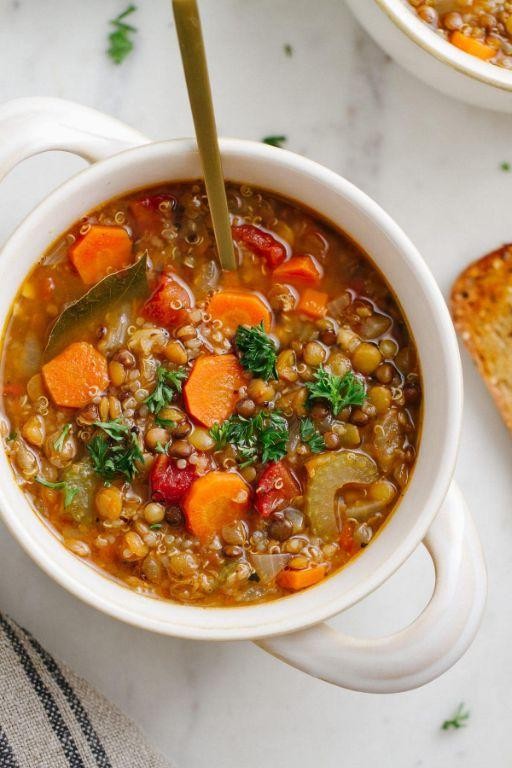
Falling leaves and crisp October air always draw me back to this comforting bowl, where earthy lentils and nutty quinoa create a sanctuary of warmth on chilly evenings. There’s something deeply nourishing about watching the spices bloom in the pot, their fragrant steam promising the kind of meal that settles both body and soul. This stew has become my autumn ritual, a gentle reminder that the simplest ingredients can hold the most profound comfort.
Ingredients
– 1 cup brown lentils (I always rinse these thoroughly to remove any dust)
– 1/2 cup quinoa (rinsing removes its natural bitterness, making all the difference)
– 1 large yellow onion, diced (sweet varieties caramelize beautifully)
– 3 cloves garlic, minced (freshly crushed releases the most aromatic oils)
– 2 carrots, chopped into 1/4-inch coins (their sweetness balances the spices perfectly)
– 1 tbsp extra virgin olive oil (my go-to for its fruity undertones)
– 4 cups vegetable broth (homemade if you have it, but store-bought works wonderfully)
– 1 tsp ground cumin (toasting whole seeds and grinding them fresh elevates the flavor)
– 1/2 tsp smoked paprika (this adds a subtle smokiness I adore)
– 1/4 tsp red pepper flakes (adjust to your heat preference, but I like just a hint)
– 1 bay leaf (it infuses such a lovely, subtle earthiness)
– 1 tbsp lemon juice (freshly squeezed right at the end brightens everything up)
– 1/4 cup chopped fresh parsley (its freshness cuts through the richness)
Instructions
1. Heat 1 tbsp extra virgin olive oil in a large pot over medium heat until it shimmers.
2. Add 1 large diced yellow onion and cook for 5 minutes, stirring occasionally, until translucent.
3. Stir in 3 cloves minced garlic and cook for 1 minute until fragrant but not browned.
4. Add 2 chopped carrots and cook for 4 minutes until slightly softened.
5. Sprinkle in 1 tsp ground cumin, 1/2 tsp smoked paprika, and 1/4 tsp red pepper flakes, toasting for 30 seconds to release their oils.
6. Pour in 1 cup rinsed brown lentils and 1/2 cup rinsed quinoa, stirring to coat with spices.
7. Add 4 cups vegetable broth and 1 bay leaf, scraping any browned bits from the pot bottom.
8. Bring to a boil, then reduce heat to low, cover, and simmer for 25 minutes until lentils and quinoa are tender.
9. Remove from heat, discard the bay leaf, and stir in 1 tbsp lemon juice and 1/4 cup chopped fresh parsley.
Just ladled into bowls, this stew cradles tender lentils and fluffy quinoa in a richly spiced broth that warms from the inside out. I love serving it with crusty bread for dipping, or sometimes topping it with a dollop of yogurt for a creamy contrast to the earthy spices.
Braised Artichokes with Lemon and Dill
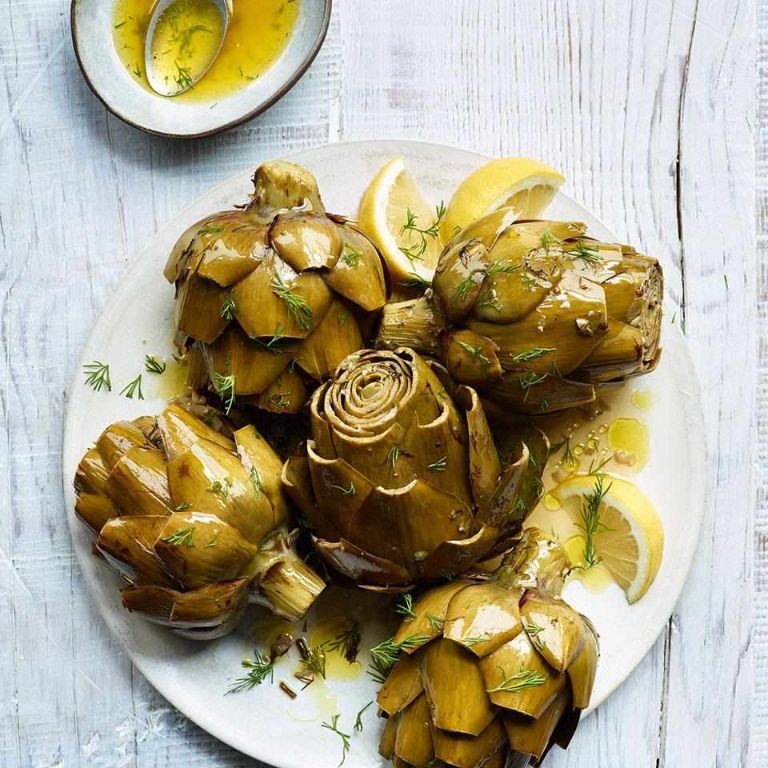
Dappled afternoon light finds me in the kitchen again, drawn to the quiet rhythm of preparing something simple yet deeply satisfying. There’s a gentle comfort in braising artichokes, their earthy fragrance mingling with lemon and dill, like a slow, thoughtful conversation with the ingredients themselves.
Ingredients
– 4 large artichokes, trimmed and halved (I like to rub the cut surfaces with lemon immediately to prevent browning)
– 1/4 cup extra virgin olive oil (my go-to for its fruity depth)
– 3 cloves garlic, thinly sliced (fresh garlic makes all the difference here)
– 1/2 cup dry white wine (a crisp Sauvignon Blanc works beautifully)
– 1 cup vegetable broth (homemade if you have it, but store-bought is fine)
– 2 tbsp fresh dill, chopped (I always use fresh—dried just doesn’t capture that bright, feathery quality)
– 1 lemon, juiced and zested (save the spent halves for stuffing into the pot)
– 1/2 tsp black pepper (freshly cracked, if possible)
– 1/2 tsp salt (I prefer fine sea salt for even distribution)
Instructions
1. Heat the olive oil in a large, heavy-bottomed Dutch oven over medium heat until it shimmers, about 2 minutes.
2. Place the artichoke halves cut-side down in the hot oil and sear until lightly golden, approximately 4–5 minutes.
3. Flip the artichokes and add the sliced garlic, stirring gently until fragrant, about 1 minute.
4. Pour in the white wine and let it bubble vigorously for 2 minutes to cook off the alcohol.
5. Add the vegetable broth, lemon juice, zest, salt, and pepper, then tuck the spent lemon halves among the artichokes.
6. Bring the liquid to a gentle simmer, then reduce the heat to low, cover the pot, and braise for 25–30 minutes until the artichoke hearts are tender when pierced with a fork.
7. Remove the lid, stir in the fresh dill, and cook uncovered for 3–4 minutes to let the flavors meld.
8. Discard the spent lemon halves and transfer the braised artichokes to a serving dish.
Buttery-soft artichoke leaves yield to a gentle pull, revealing tender hearts infused with lemon’s bright zing and dill’s grassy notes. Serve them warm alongside crusty bread to soak up the fragrant braising liquid, or flake the hearts over a grain bowl for a satisfying, plant-forward meal.
Conclusion
Overall, these 30 Mediterranean diet crock pot recipes make healthy eating deliciously simple. I hope you find inspiration to try a few! Share your favorites in the comments below, and if you loved this roundup, please pin it to your Pinterest boards to save for later. Happy slow cooking!
